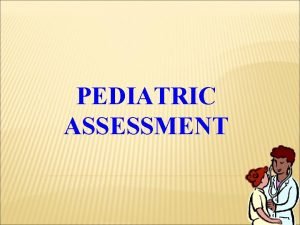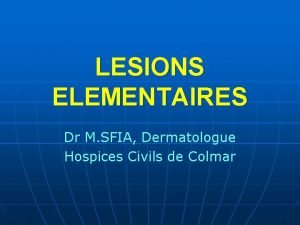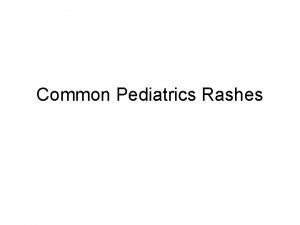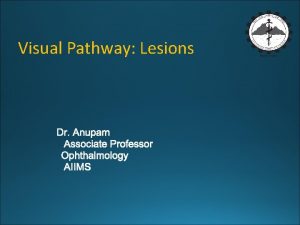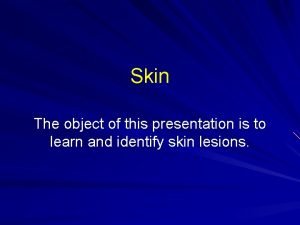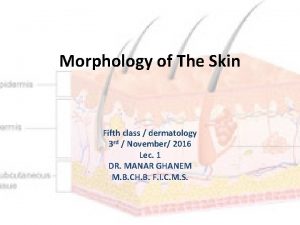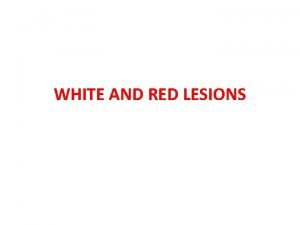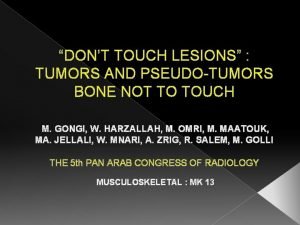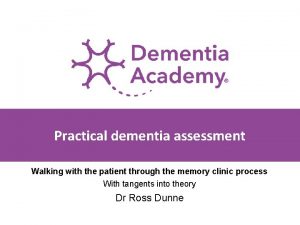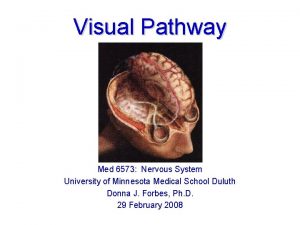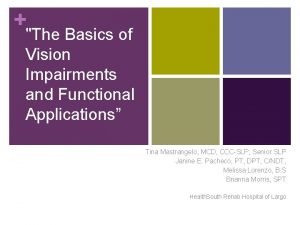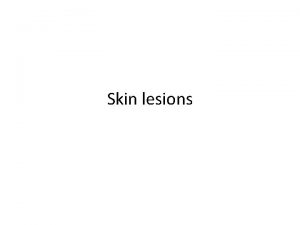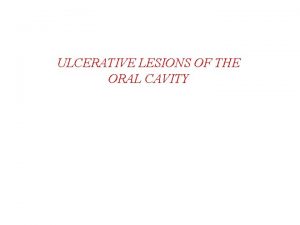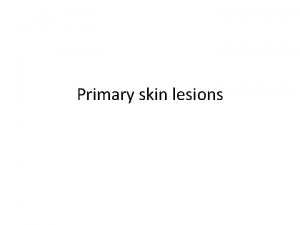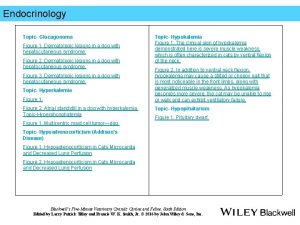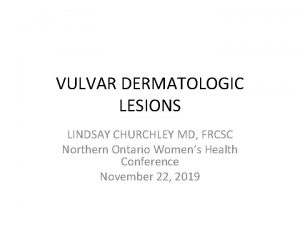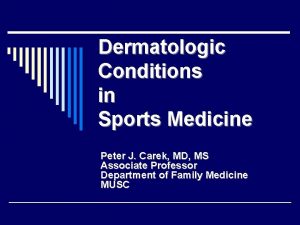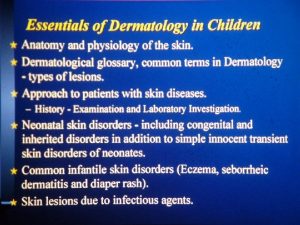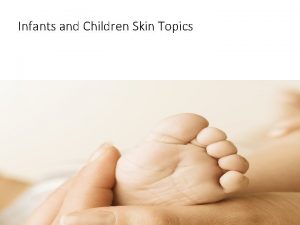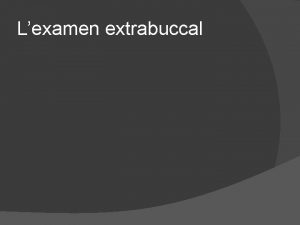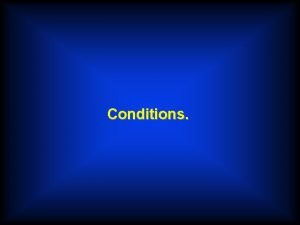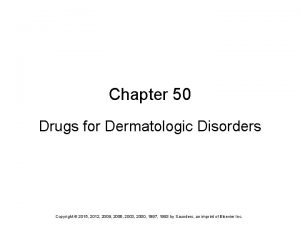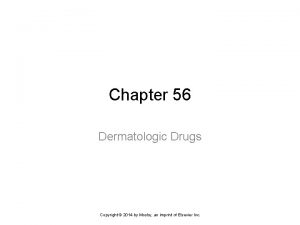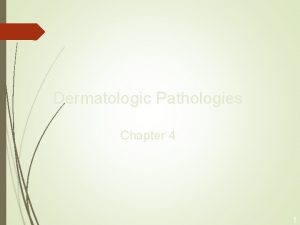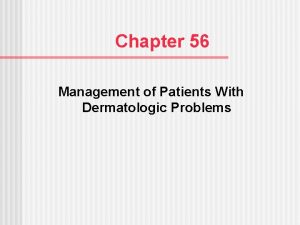Chapter 31 Dermatologic Conditions Types of Lesions Macule





















- Slides: 21

Chapter 31 Dermatologic Conditions

Types of Lesions • Macule • Vesicle • Papule • Bulla • Plaque • Pustule • Nodule • Fissure • Tumor • Ulcer • Wheal

Measures to Prevent Dermatologic Problems • Avoid drying agents, rough clothing, highly starched linens; other irritants. • Promote activity. • Use bath oils, lotions, and massages. • Avoid excessive bathing. • Promote early treatment of pruritus and skin lesions. • Avoid exposure to UV rays.

Patient Teaching Regarding Cosmetic Surgery • Encourage all persons to look their best. • Emphasize fact that no cream, lotion, or miracle drug will remove wrinkles and lines. • Encourage the use of cosmetics. • Be informed of the various types of surgical interventions. • Explore patients’ reasons for seeking cosmetic surgery.

Factors Contributing to Pruritus • Excessive bathing and dry heat • Certain Diseases – Diabetes, arteriosclerosis, hyperthyroidism, uremia, liver disease, cancer, pernicious anemia • Certain psychiatric problems

Measures to Relieve Pruritus • Bath oils, moisturizing lotions, and massage • Vitamin supplements and a high-quality, vitamin-rich diet • The topical application of zinc oxide • Antihistamines and topical steroids

Keratoses • Definition – Small, light gray or brown lesions on exposed areas of the skin – Formation of a cutaneous horn due to keratin accumulation

Keratoses (cont. ) • Treatment – Freezing agents and acids – Electrodesiccation or surgical excision – Close nursing observation for changes in keratotic lesions

Seborrheic Keratoses • Dark, wartlike projections on various parts of the body – May be as small as a pinhead or as large as a quarter. – Tend to increase in size and number with age.

Treatment of Seborrheic Keratoses • Small Seborrheic Keratoses – Abrasive activity with a gauze pad containing oil may remove them. • Larger, Raised Lesions – Can be removed by freezing agents or by a curettage and cauterization procedure.

Classification of Melanomas • Lentigo Maligna Melanoma: black, brown, white, or red pigmented flat lesion on sun-exposed areas of the body. • Superficial Spreading Melanoma: appears as variablepigmented plaque with an irregular border. • Nodular Melanoma: found on any body surface; a darkly pigmented papule that increases in size over time.

Detection and Treatment of Melanomas • Detection – Self inspection – Early detection improves the prognosis. – Evaluate and biopsy suspicious lesions. • Treatment – Usually excised with removal of some of the surrounding tissue and subcutaneous fat. – Some physicians recommend removal of all palpably enlarged lymph nodes.

Vascular Lesions • Cause – Age-related changes weaken the walls of the veins. – Weakened vessel walls cause varicose veins. • Edema of the lower extremities • Poor tissue nutrition • Legs gain a pigmented, cracked, and exudative appearance.

Nursing Measures for Stasis Ulcer • Control of infection • Good nutrition • Assistance with weight reduction • Elevation of legs • Prevention of interferences to circulation

Factors Affecting Older Adult’s Risk for Pressure Ulcers • Skin that is fragile and damages easily • A poor nutritional state • Reduced sensation of pressure and pain • Affected by immobile and edematous conditions contributing to skin breakdown

Nursing Measures to Prevent Pressure Ulcesrs • Avoid unrelieved pressure. • Encourage activity or turning of the dependent patient. • Avoid shearing forces. • Recommend a high-protein, vitamin-rich diet. • Promote good skin care.

Stages of Pressure Ulcers • Stage 1: a persistent area of skin redness (without a break in the skin); does not disappear when pressure is relieved. • Stage 2: a partial thickness loss of skin layers involving the epidermis; presents clinically as an abrasion, blister or shallow crater. • Stage 3: a full thickness of skin is lost extending through the dermis and exposing the subcutaneous tissues. • Stage 4: a full thickness of skin and subcutaneous tissue is lost, exposing muscle, bone, or both.

Protective Measures for Various Stages of Pressure Ulcers • Hyperemia: protect the skin with a product such as Duoderm (Squibb) or Tegasorb (3 M) before applying the adhesive. • Ischemia: protect with Vigilon, which contains water and is soothing to the area. • Necrosis: requires a transparent dressing that protects from bacteria but is permeable to oxygen and water vapor; irrigation is essential during dressing changes. • Ulceration: debridement is essential.

Nursing Considerations • Promoting Normalcy – Psychological support – Need for normal interactions and contacts

Using Alternative Therapies • Aloe vera for minor cuts and burns • Witch hazel for bruises and swelling • Homeopathic remedies • Acupuncture • Biofeedback • Guided imagery • Relaxation exercises • Nutritional supplements

Source • Eliopoulos, C. (2005). Gerontological Nursing, (6 th ed. ). Philadelphia: Lippincott, Williams & Wilkins (ISBN 0 -7817 -4428 -8).
 Normal pediatric vital signs
Normal pediatric vital signs Macule dyschromique
Macule dyschromique Papule vs macule
Papule vs macule Name the five lesions associated with hiv/aids chapter 17
Name the five lesions associated with hiv/aids chapter 17 Components of the visual pathway
Components of the visual pathway Extrapyramidal vs pyramidal
Extrapyramidal vs pyramidal Describing skin lesions
Describing skin lesions Epidermoid carcinoma
Epidermoid carcinoma Pustule
Pustule Olneys lesions
Olneys lesions Pyramidal vs extrapyramidal
Pyramidal vs extrapyramidal Mounts classification
Mounts classification Amiante
Amiante Classification of white lesions of oral cavity
Classification of white lesions of oral cavity Do not touch lesions
Do not touch lesions Glossopharyngeal lesion
Glossopharyngeal lesion Pr��ca it projektov�� mana����r
Pr��ca it projektov�� mana����r Scattered white matter lesions
Scattered white matter lesions Daughter mother grandmother pancreatic lesions
Daughter mother grandmother pancreatic lesions Etiology of periradicular disease
Etiology of periradicular disease Med
Med Eye lesions
Eye lesions
